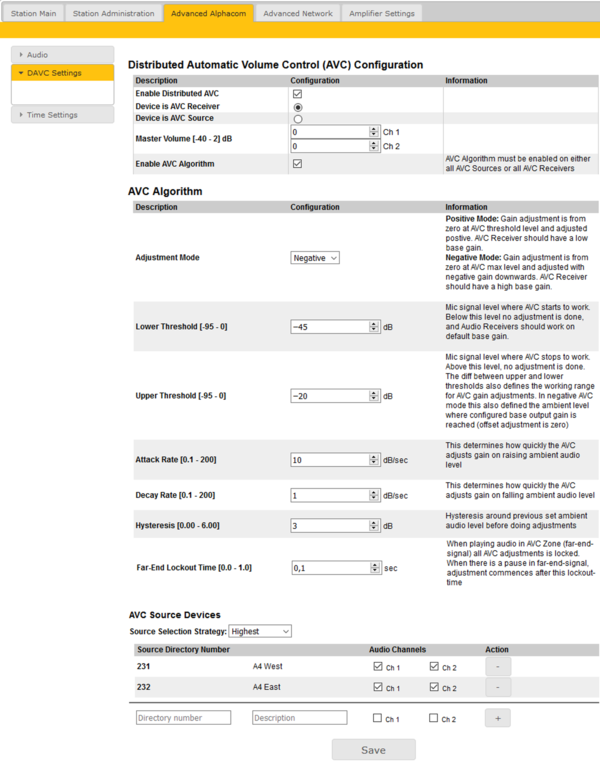Difference between revisions of "Distributed Automatic Volume Control (DAVC)"
From Zenitel Wiki
| Line 46: | Line 46: | ||
{{Note|Host name is not supported, only IP Address. Due to this, the AVC Receiver should have static IP address }} | {{Note|Host name is not supported, only IP Address. Due to this, the AVC Receiver should have static IP address }} | ||
| + | |||
| + | == Example Configuration == | ||
| + | An ENA Amplifier | ||
| + | |||
| + | === ENA Amplifier configuration === | ||
| + | The ENA Amplifier is configured to be the Audio Receiver. | ||
| + | |||
| + | |||
| + | === TKIS configuration === | ||
| + | |||
| + | |||
| + | |||
| + | |||
| + | |||
[[Category: Public Address - Features and configuration]] | [[Category: Public Address - Features and configuration]] | ||
Revision as of 14:57, 8 January 2019
The Distributed Automatic Volume Control (DAVC) is an algorithm which is using one or more microphones ("AVC Source") to measure the ambient audio/noise level, and adjusts the loudspeaker output level of the PA amplifier ("AVC Receiver") according to the ambient audio level.
The AVC Source is the input device with the listening microphone used for measuring the ambient noise level. This is typically a TKIS-kit or a TKIE-kit, but can also be a regular Turbine station.
The AVC Receiver is the output device that is used for playing audio, typically an ENA amplifier, or a PA Interface TKIS-kit or TKIE-kit.
DAVC is not operating while audio is active on the AVC Receiver. With the default configuration, it needs minimum 100ms of silence to be able to adjust the gain by 1dB. This should work just fine with normal speech, but AVC will not adjust while playing constant music.
Contents
Configuration parameters
To configure the DAVC, select Advanced AlphaCom > DAVC Settings.
Distributed Automatic Volume Control (AVC) Configuration:
- Enable Distributed AVC: Activated DAVC whern checked
- Device is AVC Receiver: This device is a "AVC Receiver"
- Device is AVC Source: This device is a "AVC Source" (listening michrophone)
- Master Volume [-40 - 2] dB: Sets the base gain when the "AVC Receiver" is an ENA Amplifier. Set a low base gain when using "Positive Mode", and a high base gain when using "Negative Mode".
- Enable AVC Algorithm: The AVC Algorithm must be enabled either on all AVC Sources or on all AVC Receivers
AVC Algorithm (visible only when Enable AVC Algorithm is checked):
- Adjustment Mode:
- Positive Mode: Gain adjustment is from zero at AVC threshold level and adjusted postive. AVC Receiver should have a low base gain.
- Negative Mode: Gain adjustment is from zero at AVC max level and adjusted with negative gain downwards. AVC Receiver should have a high base gain.
- Lower Threshold [-95 - 0 dB]: The microphone signal level where AVC starts to work. Below this level no adjustment is done, and Audio Receivers should work on default base gain
- Upper Threshold [-95 - 0 dB]: The microphone signal level where AVC stops to work. Above this level, no adjustment is done. The difference between upper and lower threshold also defines the working range for AVC gain adjustments. In negative AVC mode this also defined the ambient level where configured base output gain is reached (offset adjustment is zero)
- Attack Rate [0.1 - 200 dB/sec]: This determines how quickly the AVC adjusts gain on raising ambient audio level
- Decay Rate [0.1 - 200 dB/sec]: This determines how quickly the AVC adjusts gain on falling ambient audio level
- Hysteresis [0.00 - 6.00 dB]: Hysteresis around previous set ambient audio level before doing adjustments
- Far-End Lockout Time [0.0 - 1.0 sec]: When playing audio in AVC Zone (far-end-signal) all AVC adjustments are locked. When there is a pause in far-end-signal, adjustment commences after this lockout-time
AVC Source Devices (available only when Device is AVC Receiver is checked):
- Source Selection Strategy: The AVC Receiver will receive ambient audio levels or Gain adjust values from a number of AVC Sources. This configures the selection strategy for final gain adjusts on AVC Receiver.
- The different settings are: Highest, Average, Average Mid. Average and Average Mid require at least four AVC devices.
- Source Directory Number: The directory Number of the remote microphone devices
- Audio Channels: Which audio channel(s) on this device should be effected by signals from the remote AVC Source
AVC Receiver Configuration (available only when Device is AVC Source is checked):
- Enter the IP Address of the "AVC Receiver" and a descriptive name. Press "+" to add, then Save.

|
Host name is not supported, only IP Address. Due to this, the AVC Receiver should have static IP address |
Example Configuration
An ENA Amplifier
ENA Amplifier configuration
The ENA Amplifier is configured to be the Audio Receiver.

